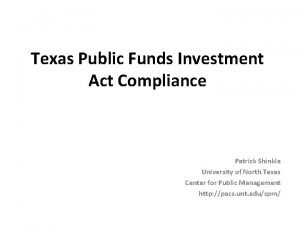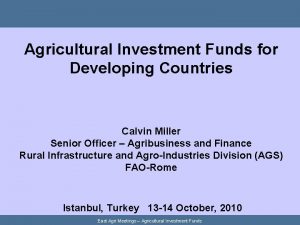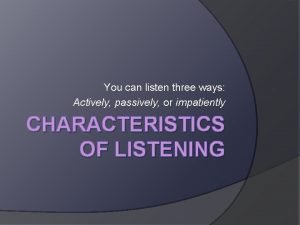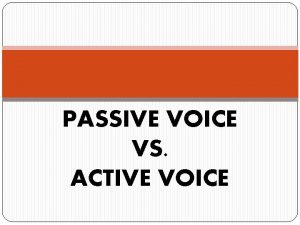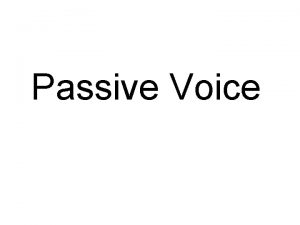Co investment Funds Active or Passive funds Whats







- Slides: 7

Co investment Funds Active or Passive funds: What’s the difference and which work best? An examination based on the UK’s Early Growth Funds Ken Cooper, Head of SME fund investment. DTI

What are co investment funds and why are they used? Two broad reasons for setting up co investment funds 1. An innovative way of providing funding for SMEs in relatively small amounts. Taking advantage of the due diligence and market knowledge of the co investor to keep running costs down. 2. A way of using EU, or other State, funding even when it has proved impossible to attract private investors willing to accept the risk of investing in a fund at a reasonable level of subordination. This presentation considers the active and passive models primarily within the first group and specifically with data relating to the DTI’s Early Growth Funds.

How the funds work, the basics: Very small VC funds struggle with costs and structures that are generally imposed as a result of the need to demonstrate that they properly manage investors’ funds. For small investments these largely fixed costs are a much bigger burden than they would be for large investments. Small businesses may also need more active investment support. These co investment funds avoid some of these costs by using the skills and diligence of the business angel/private investor. UK Government is the only investor in each fund (excl. some small investment by management teams). As a Sophisticated investor (or at least a High Net Worth investor) it can accept the less formal structure.

How the funds work: Government has no direct relationship with the private investors The EGF manager is paid a fee and gets a carried interest incentive – after a hurdle return to Government Early Growth Private investors Fund Investment / Profits SMEs

Active Funds Passive Funds Fund manager: will seek out investment opportunities publicises fund as opportunity for investors to bring deals for co investment will seek co investment partners may help build syndicate but around lead investor will negotiate terms but (in EGFs) will invest on same terms as private investor can provide advice on terms and will invest on same terms as private investor may not have access to established angel network but may help to build one will have access to an established angel network

Some comparative data: But be careful it’s a small sample and remember these funds are not yet mature. As at Dec 06 Active Passive 0. 77 0. 70 Gearing – direct 2. 04: 1 2. 78: 1 Gearing – all funds 4. 17: 1 8. 36: 1 Cost per Gov’t £ invested 0. 18 0. 21 Cost per £ invested incl. direct match 0. 06 0. 85% 1. 01% Avg. Investments per month Current value of portfolio against cost

Conclusion: Active and Passive funds look very similar on the outside because they do a similar job. The differences are on the inside. Too early to tell which is best and choice may depend on wider objectives. But both offer a different way of investing that has some advantages over the standard VC model.
 Public funds investment act training
Public funds investment act training Agricultural investment funds for developing countries
Agricultural investment funds for developing countries Fixed investment and inventory investment
Fixed investment and inventory investment Active high and active low
Active high and active low Primary active transport and secondary active transport
Primary active transport and secondary active transport Primary active transport vs secondary active transport
Primary active transport vs secondary active transport Active and passive listening
Active and passive listening Louise made the chocolate cake active or passive
Louise made the chocolate cake active or passive
